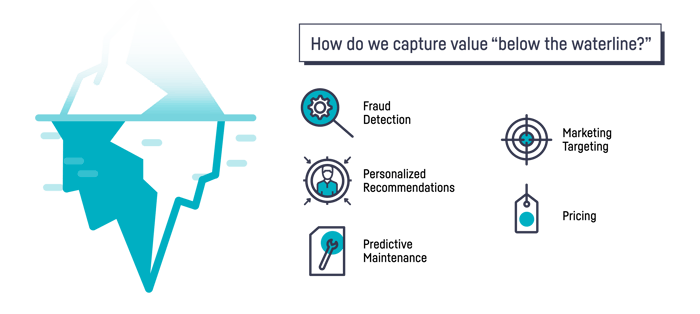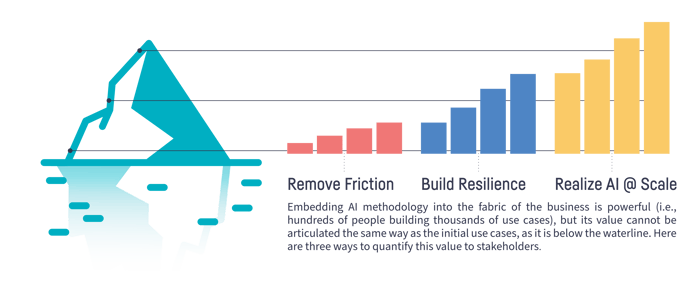What’s the problem we see with conventional business cases for AI? Well, first things first — it can take an awful lot of convincing to get your stakeholders to invest in an AI initiative. With all the people and technology you need to account for, the costs can quickly add up.
Because of these high upfront costs, you must sell some really high-value use cases to the business to get their support. For example, you can use AI to radically improve the personalization of recommendations on your website, increasing average order size. Or perhaps with a smarter approach to fraud detection you can significantly reduce losses in your e-commerce operations.
This means your whole initiative is like a highly leveraged loan: You’ve borrowed a significant sum from the business up front, promising far greater returns in future if they have faith that you will deliver. There are plenty of stories out there about when the business plan does not play out as it did on paper, the stakeholders call in their loans, and the whole thing collapses.
I won’t discuss those kinds of failures today and, instead, will focus on the problem this approach generates even if it is successful in delivering these first few use cases. Plenty of AI initiatives are not surviving and thriving beyond the success of initial use cases...but why? We’ll dig into how organizations can escape from this trap and capture the value they’re missing in what we’ll refer to as “below the waterline.”

A Significant Opportunity Awaits
Just like it sounds, below the waterline refers to the majority of the iceberg that lies below the water. The same can be said for the potential value of AI to the enterprise — while at first you’re drawn to the high-value use cases sticking out of the water, those will eventually run out. Your initial investors will be quite happy with their returns and go on their merry way. IT will also review their programs and see the highly successful projects that have been delivered.
What they miss is that Enterprise AI can’t just be a one-off special project. It needs to become a capability embedded in every part of your organization — the work of using AI to transform your business is not like “refreshing the website” or “opening an office in London” or even “migrating to the cloud” because it is never actually done. But you won’t be popular if you now go back to your stakeholders for additional funding to pursue additional use cases that did not qualify as obvious, easy, and high value up front.
In investment terms, it’s not enough to simply repay the loan on those initial use cases. You need to pay back the interest and build something that will survive and grow beyond your initial start up period. If your investment case is only around the tip of the iceberg, of course the funding will dry up even if you’re successful, and your team will leave to do more interesting work elsewhere. In the next section, we’ll provide three steps on how organizations can surface the opportunity hidden below the waterline, from the beginning of the journey.
A 3-Part Ascent
We believe that an Enterprise AI initiative should set the lofty goal of scaling to augment and optimize processes everywhere in your organization. This will mean hundreds of people building thousands of use cases, all making contributions that by themselves might appear unremarkable, but together add up to something that really matters. This prize can be transformative but its value cannot be articulated the same way as the initial use cases, as it is below the waterline. Here are some ways to quantify this value to stakeholders, so you can tell that story early and often:

1. Remove Friction
Once you know why you want to get to the top of a mountain, you obviously need to start somewhere, and run hard and fast at those early use cases that form the tip of the iceberg. This is a bit out of the scope of this post because most people are doing it well enough, but the reason we say “remove friction” here is you want maximum momentum from those initial use cases, because of what comes next.
2. Build Resilience
This step is all about making investments to mitigate risk, which in time increases your agility. Resilience is the ability to bounce back (i.e., from a global health crisis) and keep going but, as it’s a long-term investment that benefits all use cases, it requires a different value story than the one that got you started. It involves:
- Assuming technology changes at the outset to avoid costly rebuilds
Whether you are migrating data from an on-premise warehouse to Snowflake or changing public clouds, you must assume from the outset that the ground underneath you will shift constantly. It ideally won’t happen over the course of those initial use cases, which is all about the fastest possible time to value, but something will change soon. The risk and cost here is in tying your AI initiative too closely to any single way of doing things, but that is not a very attractive message for your stakeholders.
Instead, you want to build up the value of agility in the face of this change: What if by building resilience you freed the hands of others to make the infrastructure choices that will achieve their objectives? There are two streams of value you can estimate here: the cost saved by you avoiding costly rebuilds and the benefits to them of your agility.
- Leveraging diverse personas as your beacons of light on the path ahead
We sometimes hear about AI initiatives where the technical people talked to the business in some workshops, then went into a black box for months and months to build something. The problem is the longer you stay locked away from business feedback, good or bad, the more the potential you have to run off the road. But the longer you wait to re-engage, the higher the psychological cost of admitting you may have taken the wrong road in the first place.
Again, this value can be reframed from a negative into a positive, by focusing on how deep involvement by the business — preferably hands on in any AI projects — will increase their relevance and impact much more than it will slow things down. To quantify this, we recommend your initial use cases not be purely technical in nature, but explicitly prove to the business the value of this kind of collaboration.
- Building responsibly from the start to avoid compounding costs later
The more you use AI, the more you delegate decisions to these models you have built and sometimes they go wrong. When they do, the headlines look terrible for those who let this happen, and those events, while low in probability, are high in bottom-line impact if you get fined or your name is dragged through the press alongside some unflattering visual of “algorithms gone mad.”
These issues might not emerge in those initial use cases, but build a story early around what it will take to build responsibly from the start, as doing things carefully and deliberately will inevitably slow you down. The positive payoff is that putting the relevant practices in place upfront will make you more agile in the long run as you will feel safer innovating.
3. Realize AI at Scale
It really comes down to the notion that organizational transformation is worth more than the sum of your use cases. Real value comes from what’s below the waterline — what is possible in addition to specific use cases. If successful, this will completely change the future conversations with your stakeholders, elevating you out of a purely “per use case” discussion. Here, organizations should be sure to:
- Put the data people need to make decisions in front of them, instead of in silos (which will lead to faster decision making)
- Innovation should be done by everyone, not just isolated “innovation labs” (which reduces the diversity of thought on a given business problem)
- Change the way everyone works (which would, ultimately, give people more time back in their day to do the projects that matter most to them)
Key Takeaways
If you take one thing from this article, let it be the idea that you can realize the value of a broader business case that goes beyond the initial use cases. Those certainly are not unimportant, but they are proof points for something bigger that you want to achieve — something that lies below the waterline. Those lofty goals can in fact be quantified, if you move beyond use case and project-centric thinking to how the business actually works. Lastly, raise AI risk mitigation and the need for resilience from the get-go by framing them up as helpful long-term investments that increase your agility.




